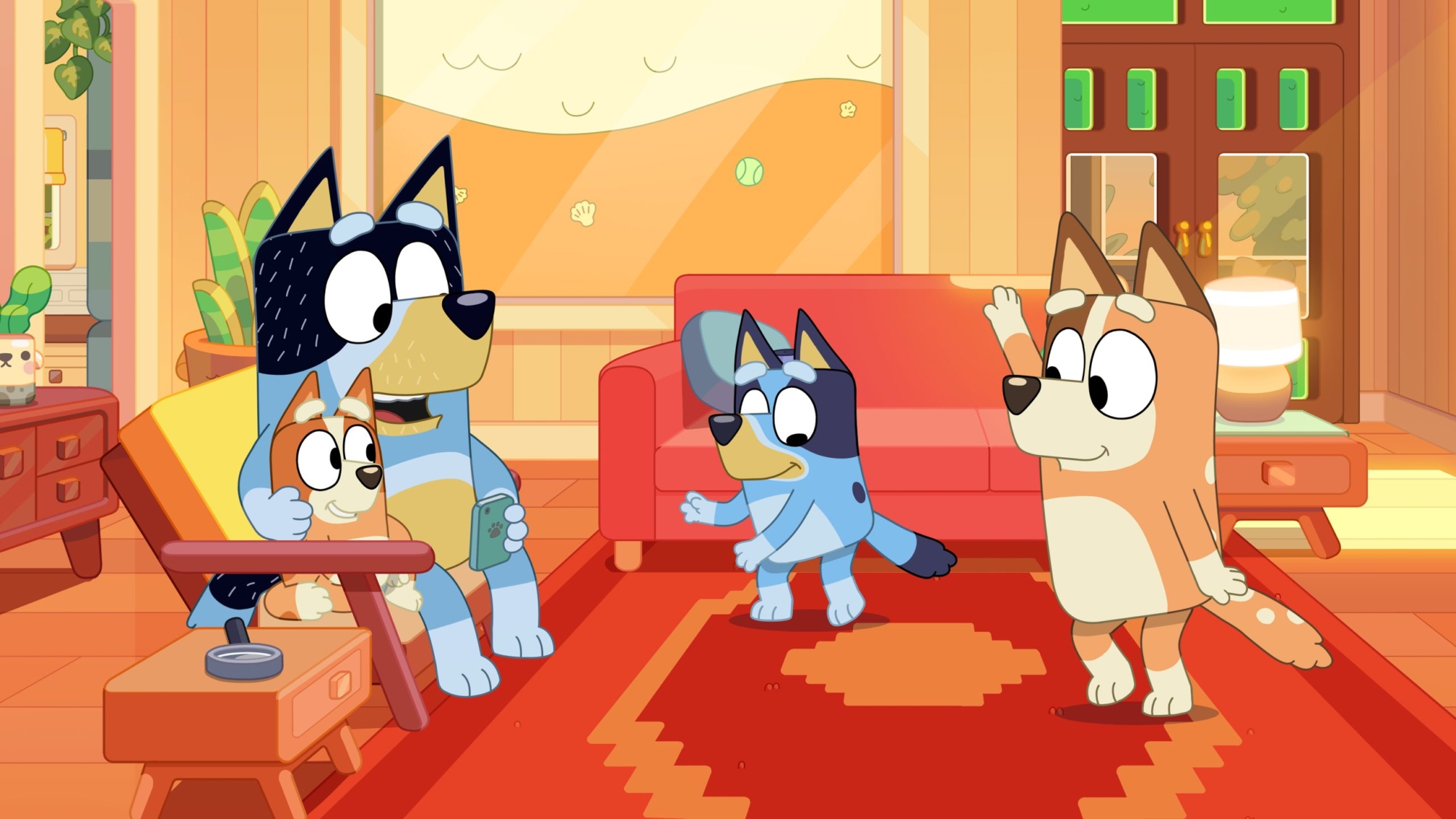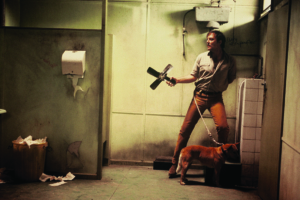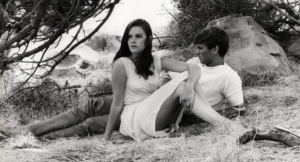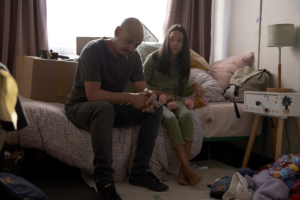Playful behaviour – engaging in activities for enjoyment or recreation –occurs across all human societies[1]See, for example, Joe L Frost, A History of Children’s Play and Play Environments: Toward a Contemporary Child-saving Movement, Routledge, New York, 2010; and Kate Darian-Smith & Simon Sleight, ‘Histories of Play’, International Journal of Play, vol. 5, no. 3, 2016, pp. 227–347. and throughout much of the rest of the animal kingdom.[2]See Marc Bekoff & John A Beyers (eds). Animal Play: Evolutionary, Comparative, and Ecological Perspectives, Cambridge University Press, Cambridge, UK, 1998. The impetus towards play appears to be an inborn impulse, and is an integral part of both our evolutionary heritage[3]See Gordon Burghardt, ‘The Mystery and Origins of Play’, IAI News, 6 April 2022, <https://iai.tv/articles/the-centrality-and-origins-of-play-auid-2095>, accessed 16 January 2024. and the socialisation process.[4]See George Herbert Mead, Play, School, and Society, Peter Lang, New York, 1999. Although ‘playing games’ might typically be seen as a childish pastime, participants and researchers alike can take playing very seriously. Research into ‘play’ is conducted by over twenty academic disciplines,[5]See ‘Scientific Disciplines Researching Play’, National Institute for Play website, <https://www.nifplay.org/play-science/scientific-disciplines-researching-play/>, accessed 16 January 2024. and the concept of ‘game’ figures centrally in many disparate fields of inquiry. Consequently, games have become central to understanding a diverse range of human behaviours: the impulse to play is arguably the foundation of all cultural experience,[6]According to historian Johan Huizinga, ‘Civilization is, in its earliest phases, played. It does not come from play like a babe detaching itself from the womb: it arises in and as play, and never leaves it.’ Huizinga, Homo Ludens: A Study of the Play Element in Culture, paperback edn, The Beacon Press, Boston, MA, 1955 [1950], p. 173. while game theory has been invoked to unify the behavioural sciences.[7]See Herbert Gintis, The Bounds of Reason: Game Theory and the Unification of the Behavioral Sciences, rev. edn, Princeton University Press, Princeton, NJ, 2014 [2009].
It’s not surprising, then, that modern scientific research[8]See, for example, Ngan Kuen Lai et al., ‘The Impact of Play on Child Development – a Literature Review’, European Early Childhood Education Research Journal, vol. 26, no.5, 2018, pp. 625–43; David Whitebread et al., ‘The Role of Play in Children’s Development: A Review of the Evidence’, white paper, The LEGO Foundation, November 2017, available at <https://cms.learningthroughplay.com/media/esriqz2x/role-of-play-in-childrens-development-review_web.pdf>, accessed 17 January 2024; and Jenny Louise Gibson, Megan Cornell & Tim Gill, ‘A Systematic Review of Research into the Impact of Loose Parts Play on Children’s Cognitive, Social and Emotional Development’, School Mental Health, vol. 9, no. 4, December 2017, pp. 295–309. has confirmed something that was already known in antiquity[9]See Plato, The Republic, Book VII, 536(b)–537(a),in John M Cooper (ed.), Plato: Complete Works, Hackett Publishing, Indianapolis, IN, 1997, pp. 1151–2. and that has been reiterated in the contemporary children’s TV series Bluey: namely, that playing games is not only a natural way for children to learn, but also the building block for their psychosocial development. The various types of play – competitive or cooperative, independent or social, free or guided – all possess an important role in a child’s cognitive, emotional, moral, physical and social development.[10]See Molly A Schlesinger et al., ‘Cognitive Behavioral Science Behind the Value of Play: Leveraging Everyday Experiences to Promote Play, Learning, and Positive Interactions’, Journal of Infant, Child, and Adolescent Psychotherapy, vol. 19, no. 2, 2020, pp. 202–16.
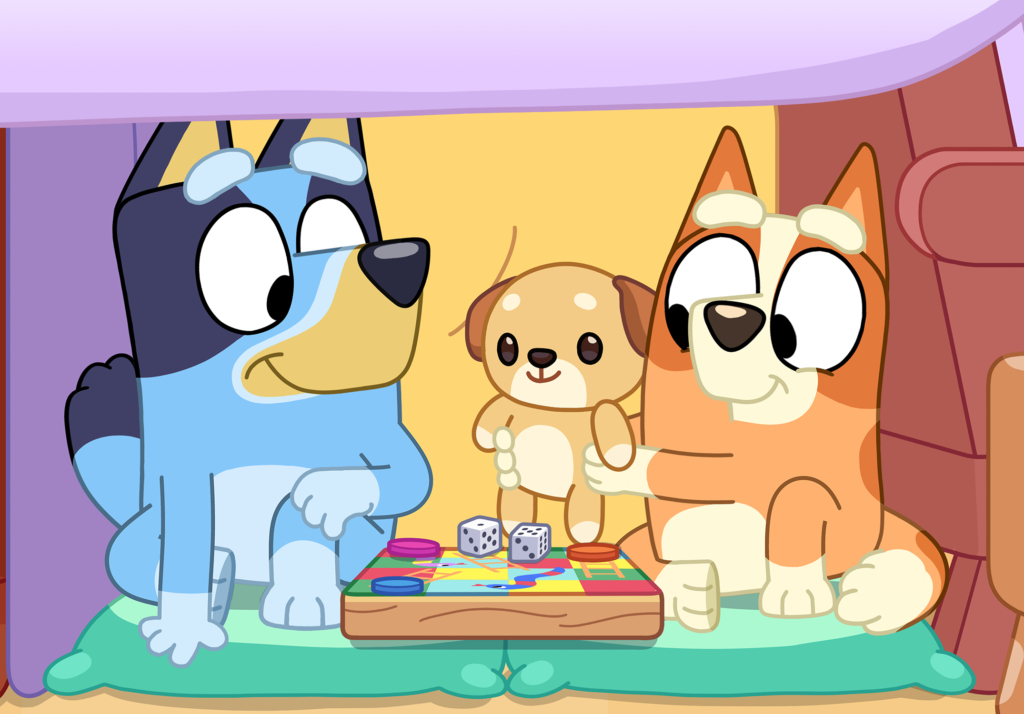
Writer/animator Joe Brumm drew on personal experience to create Bluey: his previously thriving daughter had struggled to make the transition from preschool to primary school, and a change in environment had enabled normative development via playful learning.[11]Melissa Fyfe, ‘Struggling with Pre-schoolers? Take Bluey’s Lead, Say Experts’, The Sydney Morning Herald, 10 May 2021, <https://www.smh.com.au/culture/tv-and-radio/dog-lead-why-experts-say-parents-should-follow-bluey-20210312-p57a49.html>, accessed 16 January 2024. Although Bluey might be targeted towards preschoolers, one of Brumm’s avowed aims was to model parenting skills through gameplay,[12]Stuart Heritage, ‘“Peppa Pig, with Better Parenting”: The Bounding Success of Canine Cartoon Bluey’, The Guardian, 3 June 2021, <https://www.theguardian.com/tv-and-radio/2021/jun/03/peppa-pig-with-better-parenting-the-bounding-success-of-canine-cartoon-bluey>, accessed 16 January 2024. and the interplay between psychological research and its creator’s lived experience subsequently became the show’s animating impulse.[13]Fyfe, op. cit. Bluey, however, is no exercise in arid scholarship or pedagogy; instead, over the course of three seasons and 151 seven-minute episodes (thus far), the series has taught by example. Light and playful in tone, Bluey is the televisual equivalent of an excitable puppy: filled with boundless energy, insatiable curiosity and infectious joy, it leaps out of the screen and into the open arms of its child and adult viewers alike.
The series sees the world through the eyes of two young heelers undergoing distinct stages of development: six-year-old Bluey and her four-year-old sister, Bingo.[14]Bluey and Bingo, like the other child characters in the series, are voiced by family members of production crew and are uncredited. See Leah Goulis, ‘Bluey Star Reveals Why Fans Will Never Know Who the Voices Are Behind Bluey and Bingo’, Kidspot, updated 23 November 2022, <https://www.kidspot.com.au/lifestyle/entertainment/bluey-star-reveals-why-fans-will-never-know-who-the-voices-are-behind-bluey-and-bingo/news-story/89c5891a4a05f4dbda116a6f81878589>, accessed 16 January 2024. Bluey and Bingo are, generally speaking, respectively going through the industry versus inferiority and initiative versus guilt psychological development stages, and both must learn to reconcile tensions between social requirements and their individual needs accordingly.[15]See Erik H Erikson, Identity: Youth and Crisis, WW Norton and Company, New York, 1968, pp. 91–141. Their loving parents, Bandit (David McCormack) and Chilli (Melanie Zanetti), follow their children’s lead by trying to keep up with developments and help them navigate potentially confusing or threatening situations and feelings. Bandit is a primarily stay-at-home dad,[16]According to the official website, Bandit is an archaeologist who ‘loves to dig up bones’. Given the show’s remit, however, he always appears to be at home playing with his daughters, and there is little on-screen evidence of him doing paid work until the Season 3 episode ‘Curry Quest’, in which he departs for a six-week trip to an excavation site (quickly passed over towards the end of the episode in a brief ‘hero’s journey’–style montage). See ‘Dad’, Bluey official website, <https://www.bluey.tv/characters/bandit/>, accessed 16 January 2024. and, despite periodic exasperation, often allows himself to be caught up in the whirlwind of play circling around him. Chilli is a return-to-work mum,[17]Notably, Bluey’s creators were accused of ‘mother-shaming’ when Chilli’s character bio on the official Bluey website described her as ‘sometimes fall[ing] a bit short’ of the standards of the stay-at-home mothers deemed more capable of giving children their full time, energy and attention. When this wording was criticised on social media, the production team quickly acknowledged its mistake and course-corrected. See Georgie Dent, ‘A Rare Bluey Blunder: Chilli Isn’t ‘Falling Short’ Because She Returned to Work’, Women’s Agenda, 19 November 2019, <https://womensagenda.com.au/latest/a-rare-bluey-blunder-chilli-isnt-falling-short-because-she-returned-to-work/>, accessed 16 January 2024. and a frequent voice of reason or calm; she’s the (more) responsible adult, who secures boundaries and prevents the household from descending into a maelstrom of emotion and chaos.
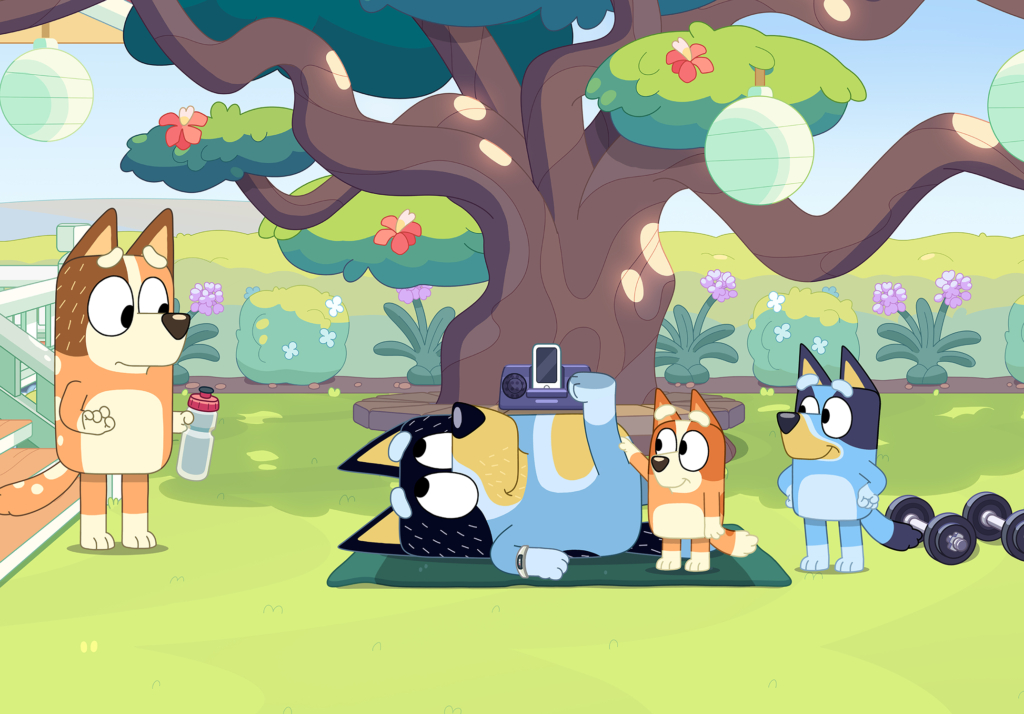
Bluey is thereby child-centred, in that it takes great care to represent children’s attempts to reconcile social expectations with individual needs and concerns. The series is frequently structured around the idea of reciprocity, or the way these competing motivations can be mutually attuned. Although the series is not built around play therapy – a technique used to ameliorate psychological difficulties through remedial agents or methods[18]See Kevin J O’Connor, Charles E Schaefer & Lisa D Braverman (eds), Handbook of Play Therapy, 2nd edn, John Wiley & Sons, Inc., Hoboken, NJ, 2015. – it nonetheless treats play as therapeutic. Specifically, Bluey uses play to create a safe space to occupy, to explore and within which a child’s developing sense of self can be optimised. Consequently, this animated series about a family of dogs remains grounded in humanistic principles and tacitly draws a parallel between the therapeutic relationship[19]For more on the therapeutic relationship, see Rita B Ardito & Daniela Rabellino, ‘Therapeutic Alliance and Outcome of Psychotherapy: Historical Excursus, Measurements, and Prospects for Research’, Frontiers in Psychology, vol. 2, 2011, available at <https://www.frontiersin.org/articles/10.3389/fpsyg.2011.00270/full>, accessed 17 January 2024. and family dynamics. The show builds rapport between its characters by creating a working alliance between parent and child; Bluey recognises that every child is a work in progress, and that parent and child must each align themselves to effectively engage with one another. As many episodes of the series demonstrate, play – activities involving agreed-upon roles, tasks and goals – is a mechanism through which parent and child can safely work through issues and process thoughts and feelings.
It is important to stress, however, that play is not so much a means to an end in Bluey as a valued end in itself: playing is done because it is fun and desirable. To quote William Shakespeare’s play Troilus and Cressida, ‘Things won are done; joy’s soul lies in the doing.’[20]William Shakespeare, Troilus and Cressida, rev. edn, Bloomsbury Arden Shakespeare, London & New York, 2015 [1602], p. 179.
Family introductions
Each episode immediately sets the tone by showing the Heeler family dancing to Joff Bush’s theme tune. This brief introductory musical sequence is a tacit acknowledgement of the show’s broad purview: to portray Bluey, the series’ ostensible lead, through the lens of a family systems perspective,[21]See Simone Pfeiffer & Tina In-Albon, ‘Family Systems’, in Gordon JG Asmundson (ed.), Comprehensive Clinical Psychology, vol. 1, 2nd edn, Elsevier, New York, 2022, pp. 185–201. or how she functions within a complex social system of which she herself is an integral part.
At first glance, it looks as if the whole family is just dancing together, and the audience is being introduced to each member as their names are called out. It becomes apparent, however, that there is something else going on with this family introduction – Bluey is also introducing the show’s thematic concerns. The Heeler family are not so much dancing but playing a game of musical statues: when the music stops, everyone is required to freeze. We are thus introduced to each member of the household as a brief misstep knocks one of them out of the game’s round. Despite their initial disappointment, each player remains emotionally invested in the game’s stakes and continues to support the others.

The episodes’ opening salvo thereby stresses the importance of family being (or moving) in sync – even when they are called ‘out’ or move out of bounds. We simultaneously learn that this space is safe for a specific reason: playgrounds are not just places in which people chose to play games and enjoy themselves; rather, games, like families, are a regulatory landscape with established boundaries, prescribed rules and behaviours enabling forward movement.
At first glance, it looks as if the whole family is just dancing together, and the audience is being introduced to each member as their names are called out. It becomes apparent, however, that there is something else going on with this family introduction – Bluey is also introducing the show’s thematic concerns.
Bluey similarly explore the theme of family as a complex self-regulatory system – a continuous entity wherein each part influences the other – in the episode ‘Musical Statues’. During this episode, everyone in the house is feeling equally out of sync, and the out-of-sorts family decides to play the titular game to regain its sense of equilibrium and momentum.
Children see, children do
Parental monitoring is, of course, parenting 101: parents need to watch their children to ensure that they are safe and being cared for. Bluey, however, frequently (and humorously) teaches parents that children are always keeping a watchful eye on them, too, and that parents thus need to carefully monitor their own behaviour. As episodes like ‘BBQ’, ‘Copycat’ and ‘Show and Tell’ illustrate, children might not be consciously aware that they are tracking adults’ actions, but are nonetheless constantly learning from their parents and other adults through observation. Specifically, they are being taught social scripts – learned behavioural patterns in given situations – through their own parents’ (inter)actions and role-playing, and these lessons take place without explicit adult guidance or instruction. Social learning theory calls this developmental process ‘observational learning’.[22]Albert Bandura, Social Learning Theory, Prentice-Hall, Englewood Cliffs, NJ, 1977, p. 22. When children imitate their parents, they are not just reproducing adult behaviours; they are internalising a regulatory system that extends beyond their immediate family circle.
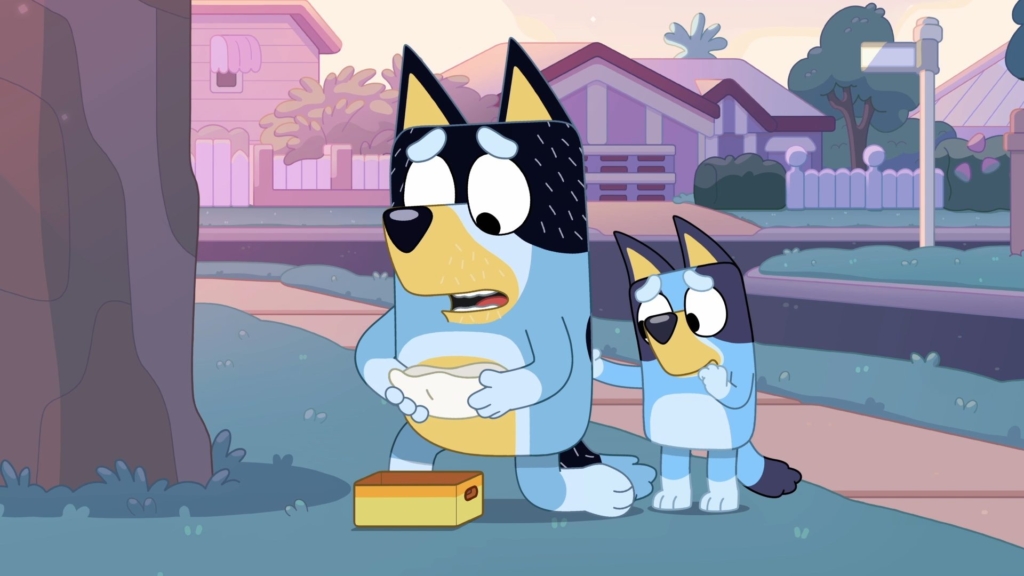
‘BBQ’, ‘Copycat’ and ‘Show and Tell’ are particularly illustrative. In the first of these, Bandit and Chilli retreat into the background during a family barbecue. The parents, however, make their presence felt through their children’s behaviour as we watch Bingo and Bluey mimic them by playing host: while Bluey pretends to cook sausages on a barbecue for Bingo and their two cousins, Bingo tries to relax in a chair, but the other two kids won’t give her a moment’s peace. Her cousins overhear Chilli talking about making a salad, and they demand the same from Bingo. Bingo runs around trying to satisfy the hard-to-please children’s arbitrary requests for ingredients, and only ends up exhausting herself. The episode is fun because neither child gives an indication that they’re imitating adult role models along gendered lines, nor that their role-playing is necessarily a faithful re-enactment of scenes from their own lives.
During ‘Copycat’, Bluey is, at least initially, fully aware of what she is doing: having fun copying whatever her father is saying or doing. For his part, Bandit tries to beat her at her own game by trying to get her to say and do things that she would otherwise not want to do. The game takes a more serious turn, however, when they discover an injured budgerigar outside. Their subsequent trip to the vet proves fruitless, and Bluey experiences death for the first time. Bluey attempts to process her feelings through role-play, but Bingo refuses to play dead in a (re)play of the day’s events. Bluey finds an alternative coping mechanism by copying Bandit’s emotional response to the death; she has learned that some things in life are beyond our understanding or control, and won’t always play out the way we want them to.
‘Show and Tell’ playfully calls into question modelling through observation. The episode shows us the limits of observational learning in two different ways: first, that parents often expect children to model themselves after adult instructions instead of their own observed actions; and second, that children tend to best understand adult rules by observing adults’ modelling behaviours. Bluey can see that Bandit’s directives can be inconsistent, domineering or confusing, and that being an adult seems to be more a case of ‘do as I say, and not as I do’. So, when his daughters start questioning his authority, Bandit decides to copy them instead. His approach thus becomes an exercise in ‘show, not tell’ as he defies the car’s guidance system on a drive to their intended destination. When they inevitably get lost, the episode effectively communicates its lesson about the importance of following rules or instructions that are intended to point us in the right direction.
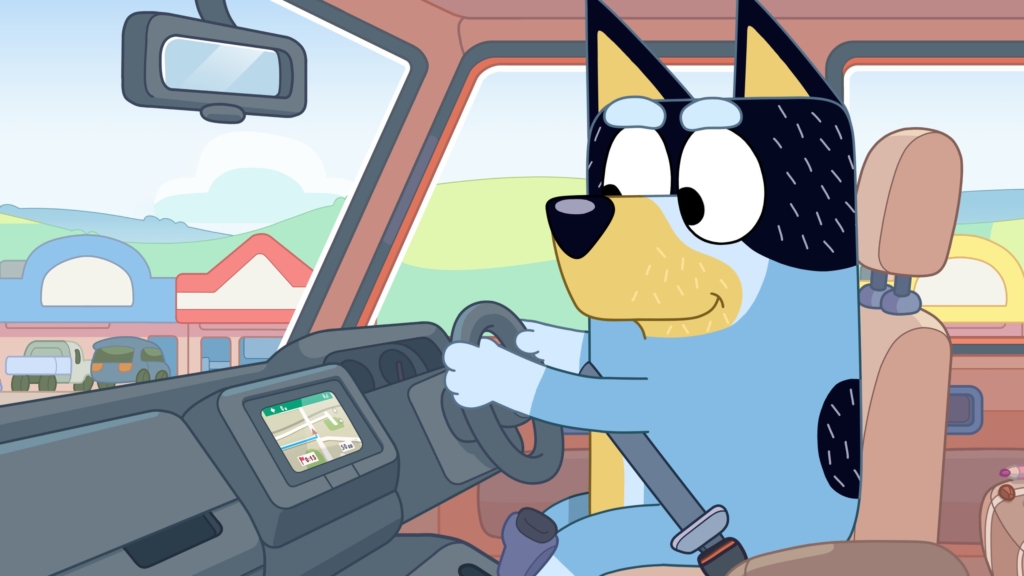
The rules of the game
Anyone watching the Heeler family will notice that individual members share resemblances in different ways. While all possess common features (such as appearance, temperament and mannerisms), the family members can only be meaningfully identified and distinguished by their relationship to one another: father, mother, daughter or sister.
Significantly, games – as different as, for instance, chess and tennis – can be seen as analogous to family. As philosopher Ludwig Wittgenstein famously observed, games ‘form a family’, in that distinct features ‘overlap and criss-cross in the same way’.[23]Ludwig Wittgenstein, Philosophical Investigations, 2nd edn, trans. GEM Anscombe, Macmillan, New York, 1958 [1953], p. 32. If games share a family resemblance, what is the nature of their identifying relationship? The answer is already familiar to us: games, like families, possess a regulatory landscape with established boundaries and delineated roles – they prescribe rules and behaviours that identify or set them apart. The only problem is that is there is a paradox at the heart of rule-following: if given rules appear to be entirely makeshift, arbitrary or unrelated, why should anyone follow rules in the first place?[24]Wittgenstein writes, ‘This was our paradox: no course of action could be determined by a rule, because every course of action can be made out to accord with the rule. The answer was: if everything can be made out to accord with the rule, then it can also be made out to conflict with it. And so there would be neither accord nor conflict here.’ ibid., p. 81.
Bluey provides a response in how it depicts children’s relationship to games. Although Bingo and Bluey were born into a world with pre-existing rules, it is their interactions with their own peer group that enforce and reinforce the social norms transmitted through intergenerational relations.[25]For more on this topic, see Isabelle Albert & Dieter Ferring (eds), Intergenerational Relations: European Perspectives on Family and Society, Polity Press, Bristol, UK, 2013. Consequently, the children’s developing understanding of what is normatively binding and/or bonding has its origins in a social contract already in play.[26]Susanne Hardecker, Marco FH Schmidt & Michael Tomasello, ‘Children’s Developing Understanding of the Conventionality of Rules’, Journal of Cognition and Development, vol. 18, no. 2, pp. 163–88, 2017. In their attempts to ensure a safe, regulated space, we witness an emerging agreement among the young players: children must learn to cooperate to experience the social benefits of their interactions. The episodes ‘Calypso’, ‘Shadowlands’ and ‘Shops’, among others, illustrate the way children learn to play by the rules: by learning to follow one another’s lead and agreeing on a way forward.
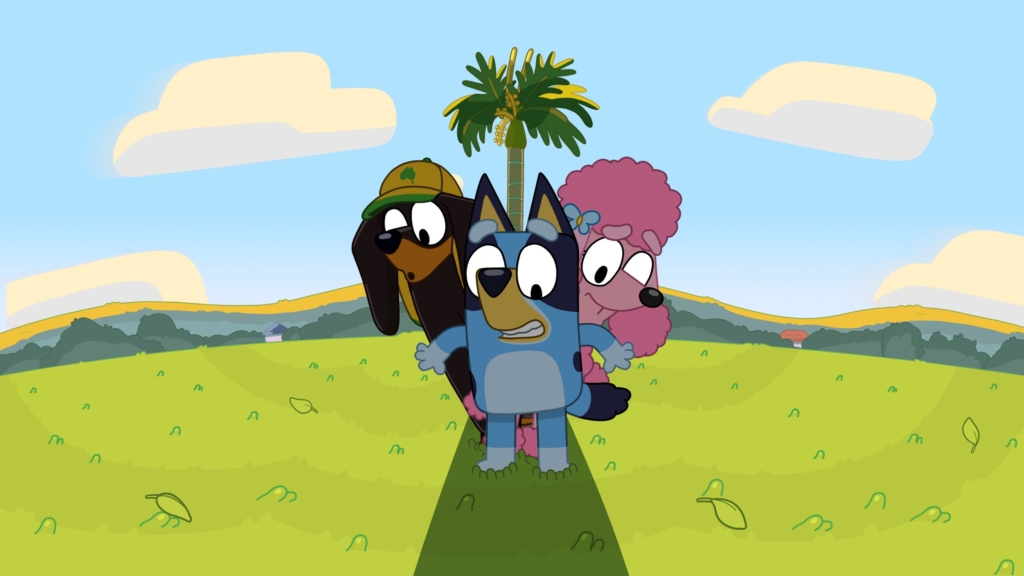
In ‘Shadowlands’, Bluey divides the playground into safe land (shadowy areas) and dangerous waters (sunlit areas) and suggests that her friends try to get across without being eaten by crocodiles. Whenever certain obstacles present themselves, one of the friends keeps trying to change the rules to make their journey easier. Bluey insists, however, that making things easier would defeat the object of the game: the fun is finding a way around obstacles and working towards solutions together. In ‘Shops’, by way of contrast, although children have agreed to role-play, they cannot agree on the roles they want to play or what the rules of their new game might entail. During this seemingly thwarted game, the increasingly frustrated children become the obstacle course: their attempt at playing together thereby develops into rule negotiation as they try to navigate their way around and accommodate one another.
When children learn that their primary caregivers are responsive to their needs and concerns, they develop an increasing sense of safety, security and autonomy. The feeling of a parent as a secure base is foundational: if a child understands that there is someone safe they can return to for comfort or support, they will be able to explore potentially threatening spaces and situations.
‘Calypso’, an episode set at Bluey’s preschool, culminates with an idealised vision of this process – one in which everyone has a role to play and a space to make safe for one another. Much as children learn to naturally attune their behaviour to one another through play activities and/or the process of accommodation and integration, all the students at the preschool are playing separate games and appear to be in their own rule-governed headspace. Their teacher, Calypso (Meg Washington), however, gently coaxes them to enter one another’s imaginary space and facilitates a state of interdependent coexistence modelled on a well-functioning society.

Separation anxiety
Emotional bonds are integral to intergenerational family relations and social dynamics. According to attachment theory, these intimate bonds originally emerge between a parent and child and remain part of the life cycle: styles of attachment influence the way children develop and relate to other people (including their own children in later life).[27]Mary D Salter Ainsworth et al., Patterns of Attachment: A Psychological Study of the Strange Situation, Taylor & Francis, New York, 2015. As the episodes ‘Sleepytime’ and ‘Space’ acknowledge, however, parent and child cannot be literally attached to each other, and increasingly anxious or insecure children must bridge the divide between emotional attachment and physical separation. Attachment theory explains how such a development takes place. Specifically, when children learn that their primary caregivers are responsive to their needs and concerns, they develop an increasing sense of safety, security and autonomy. The feeling of a parent as a secure base is foundational: if a child understands that there is someone safe they can return to for comfort or support, they will be able to explore potentially threatening spaces and situations.[28]See John Bowlby, A Secure Base: Parent–Child Attachment and Healthy Human Development, Basic Books, New York, 1988.
‘Sleepytime’ and ‘Space’ similarly approach the theme of parent as secure base through different experiences of space travel: emotional security is represented as a radiating sun in ‘Sleepytime’; and emotional insecurity appears as a black hole in ‘Space’. The justifiably celebrated[29]‘Sleepytime’ has received a Prix Jeunesse International Award, and both The Guardian and The New York Times, among others, have singled it out for praise. It also appears to be the most popular Bluey episode, and at point figured prominently in IMDb’s list of top-rating TV episodes of all time. See James Poniewozik, Mike Hale & Margaret Lyons, ‘The Best TV Episodes of 2020’, The New York Times, updated 18 December 2020, <https://www.nytimes.com/2020/12/17/arts/television/best-tv-episodes.html>; Andrew P Street, ‘The 10 Best Bluey Episodes, for Both Kids and Parents – Sorted’, The Guardian, 21 March 2022, <https://www.theguardian.com/culture/2022/mar/21/the-10-best-bluey-episodes-for-both-kids-and-parents-sorted>; and Leah Goulis, ‘Bluey Conspiracy Theory Surrounding Top Ranking of Sleepytime Episode’, Kidspot, 24 February 2023, <https://www.kidspot.com.au/lifestyle/bluey-conspiracy-theory-surrounding-top-ranking-of-sleepytime-episode-on-imdb/news-story/0b0858f04e65b5ebd46435a1b4e36b03>, all accessed 17 January 2024. ‘Sleepytime’ playfully explores Bingo’s decision to wake up in her own bed, while ‘Space’ is about Bluey’s friend Mackenzie dealing with feelings of abandonment in the playground.

During ‘Sleepytime’, we enter Bingo’s dream world and watch her embark on an intergalactic adventure. The music ‘playing’ in the background, based on Gustav Holst’s orchestral suite The Planets, underscores what she is feeling during her flight of fancy. Bingo is exploring separation from her mother at night in a displaced way: her dream is about letting her security soft toy, Floppy, go and play with all the other children’s Floppys circling Saturn. As Bingo – ‘a big girl now’, in her mother’s words – finds herself alone and far away from home, she remains caught in the glowing Sun’s (aka Chilli’s) gravitational pull, or loving embrace: ‘Remember I’ll always be here for you, even if you can’t see me, because I love you,’ her mother reassures her.
Although Mackenzie is playing astronauts in ‘Space’, he keeps separating himself from his playmates. It is only when he decides to go into a dark place that he begins to see why he keeps abandoning their mission to Mars. Mackenzie is replaying a traumatic memory related to losing sight of his mother on a slide. When he emerges out of the black hole into sunlight, Chilli is there to reassure him that his mother is also close by. ‘You know what’s here now. You don’t need to keep coming back to this place.’
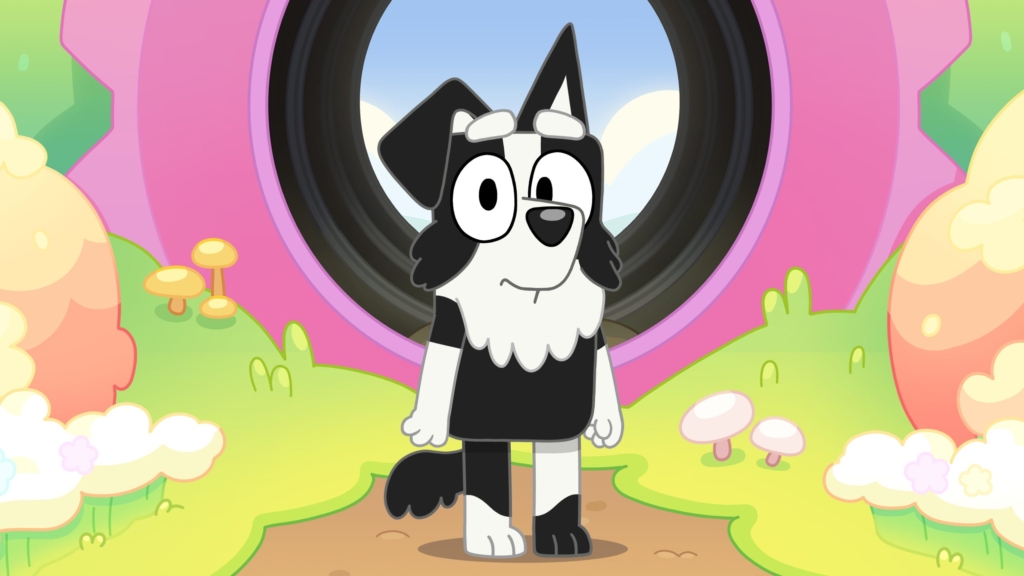
Life is a journey
A child’s psychosocial trajectory is typically built upon three foundations: self-esteem, resilience and self-regulation. Ideally, children would learn to value their own abilities and attributes while also learning to cope with perceived obstacles or setbacks. Developing the capacity to regulate emotions thereby ensures that their reactions remain proportional. A developmental systems approach explains the way humans move through life stages: normative developmental processes are the result of neither genetic inheritance nor environmental factors, but the interplay between them.[30]See Peter CM Molenaar, Richard M Lerner & Karl M Newell (eds), Handbook of Developmental Systems Theory & Methodology, The Guilford Press, New York, 2014.
In making its case for self-esteem and resilience as means of self-regulation, Bluey explores these processes in myriad ways. In, ‘Bike’, we witness Bluey struggling with feelings of inadequacy: she is deterred by the fact that riding a bike isn’t as easy as it looked. The normally proactive child must first learn to manage her expectations, frustrations and disappointments before she can learn to ride; success is only possible through trial and error. Significantly, what motivates her to keep trying is learning through peer modelling, through watching undeterred children overcome their own trials in the playground.
In ‘Dance Mode’ and ‘Yoga Ball’, the sensitive and typically reactive Bingo is more inclined to please others than to stand up for herself or set boundaries: she initially finds herself dealing with feelings of resentment and powerlessness, but learns to develop self-efficacy through consensual play. In ‘Bad Mood’, she instead develops control over her emotions and behaviour through Bandit, who consents to wreaking havoc on her behalf. While Bingo discovers that she enjoys acting out, she also learns that such impulsive and uncontrollable behaviour can be self-destructive and potentially injurious to others.
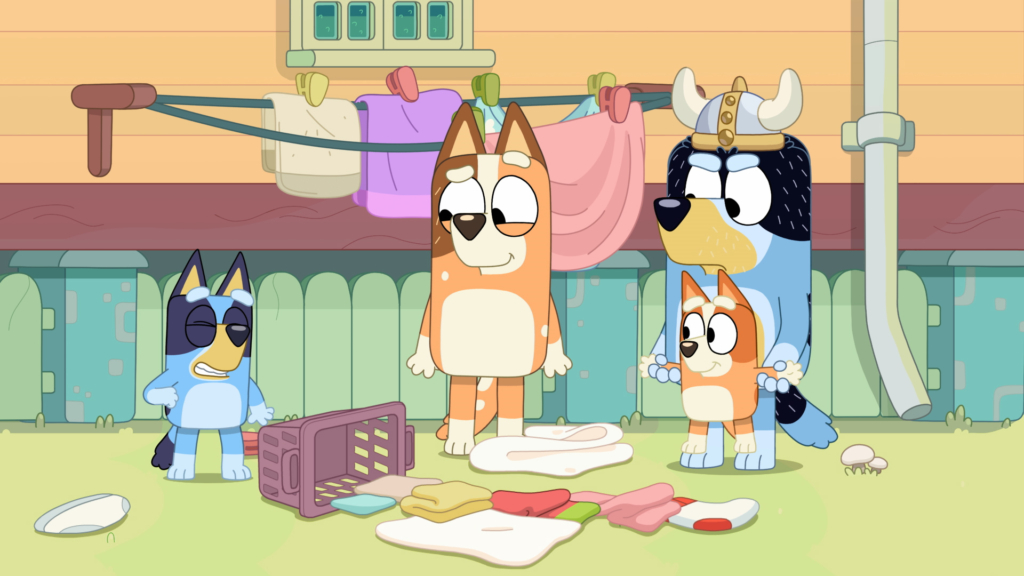
Both girls are reluctant to accept responsibility for themselves in ‘Daddy Robot’, and must learn the hard way. When the disgruntled children are asked to clean their playroom, they try to take the easy way out by activating ‘Daddy Robot’ to do it for them. An initially compliant robot, however, decides to follow their lead when he realises that it would be easier to take the kids out to the rubbish bin instead. Their resistance results in a malfunction in the system, and the kids learn an important lesson: a functional family must be in sync and pull in the same direction.
Although emotional attachments might be seen as a natural development, ‘Flat Pack’ goes so far as to paint family ties as a spiritual development: being part of the biological life cycle, the episode suggests, is to experience the divine.
The series’ depiction of the interplay between nature and nurture reaches its apotheosis in ‘Flat Pack’. While Bandit and Chilli are struggling to assemble furniture, Bluey and Bingo transform discarded boxes into environments in which they can ‘change’ into different prehistoric animals, charting an evolutionary path through the history of life on Earth. The episode’s intended implication is clear: a child’s developmental journey is analogous to evolution through natural selection. Although emotional attachments might be seen as a natural development, ‘Flat Pack’ goes so far as to paint family ties as a spiritual development: being part of the biological life cycle, the episode suggests, is to experience the divine.
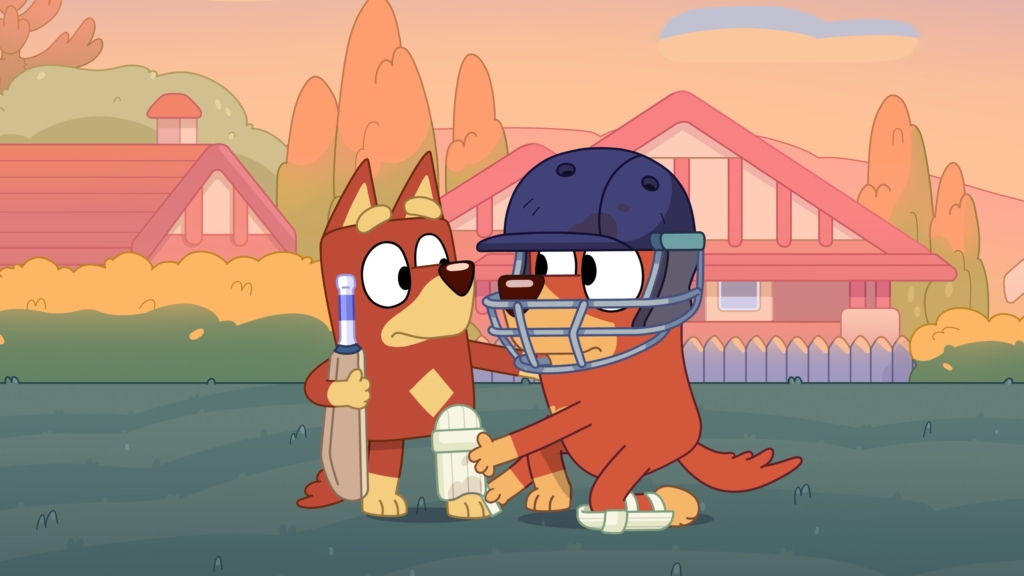
‘Cricket’, in contrast, grounds experiences of the transcendent within the values of fairness and respect for other players. The titular sport is not just about hitting a ball with a bat or chasing it around; rather, the game offers its participants a level playing field. In the process, it also teaches young players the value of being a good sport by winning and losing gracefully, both aiding their moral development and showing how culture can be passed down through generations. This is an evolutionary process of another kind: through play, generational characteristics are transferred and replicated. In the episode, children and parents play together, creating an unexpected challenge to the order of things. When young batsman Rusty unexpectedly beats the adults at their own game, they conspire to bowl him out in order to reclaim their dignity. Nonetheless, practice has made perfect, and Rusty has already been taught to meet any challenge thrown at him. He has also learned that there are some things more important than winning – like making sure his little sister feels included by letting her catch him out.
Endnotes
| 1 | See, for example, Joe L Frost, A History of Children’s Play and Play Environments: Toward a Contemporary Child-saving Movement, Routledge, New York, 2010; and Kate Darian-Smith & Simon Sleight, ‘Histories of Play’, International Journal of Play, vol. 5, no. 3, 2016, pp. 227–347. |
|---|---|
| 2 | See Marc Bekoff & John A Beyers (eds). Animal Play: Evolutionary, Comparative, and Ecological Perspectives, Cambridge University Press, Cambridge, UK, 1998. |
| 3 | See Gordon Burghardt, ‘The Mystery and Origins of Play’, IAI News, 6 April 2022, <https://iai.tv/articles/the-centrality-and-origins-of-play-auid-2095>, accessed 16 January 2024. |
| 4 | See George Herbert Mead, Play, School, and Society, Peter Lang, New York, 1999. |
| 5 | See ‘Scientific Disciplines Researching Play’, National Institute for Play website, <https://www.nifplay.org/play-science/scientific-disciplines-researching-play/>, accessed 16 January 2024. |
| 6 | According to historian Johan Huizinga, ‘Civilization is, in its earliest phases, played. It does not come from play like a babe detaching itself from the womb: it arises in and as play, and never leaves it.’ Huizinga, Homo Ludens: A Study of the Play Element in Culture, paperback edn, The Beacon Press, Boston, MA, 1955 [1950], p. 173. |
| 7 | See Herbert Gintis, The Bounds of Reason: Game Theory and the Unification of the Behavioral Sciences, rev. edn, Princeton University Press, Princeton, NJ, 2014 [2009]. |
| 8 | See, for example, Ngan Kuen Lai et al., ‘The Impact of Play on Child Development – a Literature Review’, European Early Childhood Education Research Journal, vol. 26, no.5, 2018, pp. 625–43; David Whitebread et al., ‘The Role of Play in Children’s Development: A Review of the Evidence’, white paper, The LEGO Foundation, November 2017, available at <https://cms.learningthroughplay.com/media/esriqz2x/role-of-play-in-childrens-development-review_web.pdf>, accessed 17 January 2024; and Jenny Louise Gibson, Megan Cornell & Tim Gill, ‘A Systematic Review of Research into the Impact of Loose Parts Play on Children’s Cognitive, Social and Emotional Development’, School Mental Health, vol. 9, no. 4, December 2017, pp. 295–309. |
| 9 | See Plato, The Republic, Book VII, 536(b)–537(a),in John M Cooper (ed.), Plato: Complete Works, Hackett Publishing, Indianapolis, IN, 1997, pp. 1151–2. |
| 10 | See Molly A Schlesinger et al., ‘Cognitive Behavioral Science Behind the Value of Play: Leveraging Everyday Experiences to Promote Play, Learning, and Positive Interactions’, Journal of Infant, Child, and Adolescent Psychotherapy, vol. 19, no. 2, 2020, pp. 202–16. |
| 11 | Melissa Fyfe, ‘Struggling with Pre-schoolers? Take Bluey’s Lead, Say Experts’, The Sydney Morning Herald, 10 May 2021, <https://www.smh.com.au/culture/tv-and-radio/dog-lead-why-experts-say-parents-should-follow-bluey-20210312-p57a49.html>, accessed 16 January 2024. |
| 12 | Stuart Heritage, ‘“Peppa Pig, with Better Parenting”: The Bounding Success of Canine Cartoon Bluey’, The Guardian, 3 June 2021, <https://www.theguardian.com/tv-and-radio/2021/jun/03/peppa-pig-with-better-parenting-the-bounding-success-of-canine-cartoon-bluey>, accessed 16 January 2024. |
| 13 | Fyfe, op. cit. |
| 14 | Bluey and Bingo, like the other child characters in the series, are voiced by family members of production crew and are uncredited. See Leah Goulis, ‘Bluey Star Reveals Why Fans Will Never Know Who the Voices Are Behind Bluey and Bingo’, Kidspot, updated 23 November 2022, <https://www.kidspot.com.au/lifestyle/entertainment/bluey-star-reveals-why-fans-will-never-know-who-the-voices-are-behind-bluey-and-bingo/news-story/89c5891a4a05f4dbda116a6f81878589>, accessed 16 January 2024. |
| 15 | See Erik H Erikson, Identity: Youth and Crisis, WW Norton and Company, New York, 1968, pp. 91–141. |
| 16 | According to the official website, Bandit is an archaeologist who ‘loves to dig up bones’. Given the show’s remit, however, he always appears to be at home playing with his daughters, and there is little on-screen evidence of him doing paid work until the Season 3 episode ‘Curry Quest’, in which he departs for a six-week trip to an excavation site (quickly passed over towards the end of the episode in a brief ‘hero’s journey’–style montage). See ‘Dad’, Bluey official website, <https://www.bluey.tv/characters/bandit/>, accessed 16 January 2024. |
| 17 | Notably, Bluey’s creators were accused of ‘mother-shaming’ when Chilli’s character bio on the official Bluey website described her as ‘sometimes fall[ing] a bit short’ of the standards of the stay-at-home mothers deemed more capable of giving children their full time, energy and attention. When this wording was criticised on social media, the production team quickly acknowledged its mistake and course-corrected. See Georgie Dent, ‘A Rare Bluey Blunder: Chilli Isn’t ‘Falling Short’ Because She Returned to Work’, Women’s Agenda, 19 November 2019, <https://womensagenda.com.au/latest/a-rare-bluey-blunder-chilli-isnt-falling-short-because-she-returned-to-work/>, accessed 16 January 2024. |
| 18 | See Kevin J O’Connor, Charles E Schaefer & Lisa D Braverman (eds), Handbook of Play Therapy, 2nd edn, John Wiley & Sons, Inc., Hoboken, NJ, 2015. |
| 19 | For more on the therapeutic relationship, see Rita B Ardito & Daniela Rabellino, ‘Therapeutic Alliance and Outcome of Psychotherapy: Historical Excursus, Measurements, and Prospects for Research’, Frontiers in Psychology, vol. 2, 2011, available at <https://www.frontiersin.org/articles/10.3389/fpsyg.2011.00270/full>, accessed 17 January 2024. |
| 20 | William Shakespeare, Troilus and Cressida, rev. edn, Bloomsbury Arden Shakespeare, London & New York, 2015 [1602], p. 179. |
| 21 | See Simone Pfeiffer & Tina In-Albon, ‘Family Systems’, in Gordon JG Asmundson (ed.), Comprehensive Clinical Psychology, vol. 1, 2nd edn, Elsevier, New York, 2022, pp. 185–201. |
| 22 | Albert Bandura, Social Learning Theory, Prentice-Hall, Englewood Cliffs, NJ, 1977, p. 22. |
| 23 | Ludwig Wittgenstein, Philosophical Investigations, 2nd edn, trans. GEM Anscombe, Macmillan, New York, 1958 [1953], p. 32. |
| 24 | Wittgenstein writes, ‘This was our paradox: no course of action could be determined by a rule, because every course of action can be made out to accord with the rule. The answer was: if everything can be made out to accord with the rule, then it can also be made out to conflict with it. And so there would be neither accord nor conflict here.’ ibid., p. 81. |
| 25 | For more on this topic, see Isabelle Albert & Dieter Ferring (eds), Intergenerational Relations: European Perspectives on Family and Society, Polity Press, Bristol, UK, 2013. |
| 26 | Susanne Hardecker, Marco FH Schmidt & Michael Tomasello, ‘Children’s Developing Understanding of the Conventionality of Rules’, Journal of Cognition and Development, vol. 18, no. 2, pp. 163–88, 2017. |
| 27 | Mary D Salter Ainsworth et al., Patterns of Attachment: A Psychological Study of the Strange Situation, Taylor & Francis, New York, 2015. |
| 28 | See John Bowlby, A Secure Base: Parent–Child Attachment and Healthy Human Development, Basic Books, New York, 1988. |
| 29 | ‘Sleepytime’ has received a Prix Jeunesse International Award, and both The Guardian and The New York Times, among others, have singled it out for praise. It also appears to be the most popular Bluey episode, and at point figured prominently in IMDb’s list of top-rating TV episodes of all time. See James Poniewozik, Mike Hale & Margaret Lyons, ‘The Best TV Episodes of 2020’, The New York Times, updated 18 December 2020, <https://www.nytimes.com/2020/12/17/arts/television/best-tv-episodes.html>; Andrew P Street, ‘The 10 Best Bluey Episodes, for Both Kids and Parents – Sorted’, The Guardian, 21 March 2022, <https://www.theguardian.com/culture/2022/mar/21/the-10-best-bluey-episodes-for-both-kids-and-parents-sorted>; and Leah Goulis, ‘Bluey Conspiracy Theory Surrounding Top Ranking of Sleepytime Episode’, Kidspot, 24 February 2023, <https://www.kidspot.com.au/lifestyle/bluey-conspiracy-theory-surrounding-top-ranking-of-sleepytime-episode-on-imdb/news-story/0b0858f04e65b5ebd46435a1b4e36b03>, all accessed 17 January 2024. |
| 30 | See Peter CM Molenaar, Richard M Lerner & Karl M Newell (eds), Handbook of Developmental Systems Theory & Methodology, The Guilford Press, New York, 2014. |
